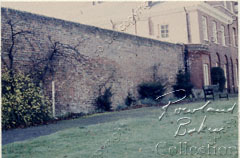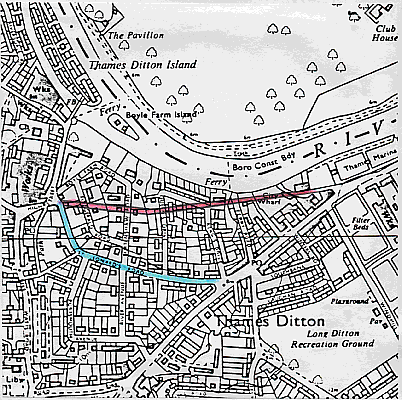| Boyle Farm - Mrs. Charlotte Digby |
By the next year the lessee of Fords was an aristocratic widow by the name of the Hon. Mrs. Charlottee Digby.
Mrs. Digby was the daughter of Sir Stephen Fox, a Whig politician. Thus carrying on the association of this house with the Whig faction, which started with Col. Godolphin, continued with William Baker, and extended with many others yet to come.
Fox was reputed to be the richest commoner in the kingdom, and was seventeen times a lord of the treasury. He was the man who first suggested to Charles the second the building of Chelsea Hospital for retired soldiers(65). He had married for a second time when in his late seventies a girl of twenty-four, and they had four children, of whom Charlotte was the youngest. She was born when her father was eighty years old. She married the only surviving son of the fifth lord Digby, but had been widowed for several years when she moved to Thames Ditton. Two of her sons in turn inherited the title of baron Digby(66).
The freehold landlord of the estate was still George Tash of Buckinghamshire. In 1758, soon after Mrs. Digby had taken over the tenancy, he decided to reinsure the property against fire, the policy taken out by Sidney Godolphin having lapsed on the death of his daughter. Luckily for us this time he chose to use the Hand-in-Hand Insurance Society. Luckily, because they were one of the few societys who recorded full details of the insured property in their policy registers, and these have been conscientiously preserved and are now deposited in the Guildhall Library in London.
This record gives us the only known description of the house as it then stood. It tells us that it was "a House &c on the East side of the Road in the parish of Thames Ditton Com. Surry & now in the possession of the Hon. Mrs. Digby". The house itself was built of brick, two stories high, consisting of a centre block forty-two feet long by twenty-two feet wide, with two identical wings, each forty feet by twenty-one feet. But does not indicate the juxtaposition of the three parts - whether they were all in line, or whether they were H or U shaped. The outbuildings were; a barn, laundry, coalhouse, sheds, three separate sets of stables, and a coach-house; partly brick and partly timber. The complete dimensions of each of these are stipulated. The house was valued at £862, and the other buildings at a combined figure of £338(67). This sum is vastly in excess of the value at which it was assessed for Godolphin's policy issued only thirty-six years earlier. It can only be assumed, therefore, that in the meanwhile the house had been much enlarged, perhaps by the addition of the two wings mentioned.
 |
Wall on the north-east corner of the present house. Possibly part of the stable block or coach-house of the original building mentioned in the insurance policy of 1758. Note bricked up gateway and lack of windows. |
In 1763 George Tash and Mrs. Digby came to an agreement for her to purchase the freehold of the house, together with various other pieces of land, freehold and copyhold, in Thames Ditton and East Molesey, for a total price of £7,000(68). It was still the second largest house in the parish, exceeded only by Ember Court, but as that was somewhat removed from the village itself, the owner of Fords was considered to be the local squire.
Mrs Digby, who was a wealthy woman, having inherited a considerable fortune from her father(69), commenced upon a process of enlarging and improving the estate, which heightened her standing in the community even further. Firstly, she purchased what is now known as "Thames Ditton Island" (then called "Ditton Hill") (70), and the two smaller islands nearby, which were copyhold of the manor and honour of Hampton Court(71). Secondly, she acquired a total of twenty-three acres in several pieces, including a field known as "Stones" which stood on the south side of Summer Road (then known as "Moulsey Lane"), and some land in a common field called "Beeston Field" (Otherwise "Basingfield") (72).
At that time the road from Thames Ditton village to Kingston ran from the High Street by where the Fountain now stands, eastward in more or less a straight line, crossing the river Rythe and passing close to Long Ditton wharf, to the Portsmouth Road behind where the City Arms public house now is. And was known, as one might expect, as "Wharf Road" .
The garden of Fords stood adjacent to the northern side of this road, right up to the Rythe(73).
Part of the land purchased by Mrs. Digby was on the further side on this road, and was known as "The fifteen Acres". Thinking that it would be distinctly advantageous to throw this land into the curtilage of the house and make it part of the garden, with the additional benefit of moving the road further away from the house, she obtained from the crown a writ of Ad Quod Damnum, which obliged the sherriff of the county to hold an inquiry to ascertain if any harm would arise to anyone if she was allowed to divert the road to a new alignment(74).
On 11 January 1771, therefore, the sherriff of Surrey, Sir Richard Hotham, called together on the site twenty "honest and lawful men" from the district. They decided that no harm or prejudice would occur from such a diversion; and at the next general quarter sessions Mrs. Digby was granted permission to "completely and substantially make another Road or Highway - in her own Land and Soil - of the Breadth of Thirty Feet in the clear from Ditch to Ditch. Beginning "at the stable in the occupation of the Reverend Mr. Dry"(75) across to "a certain Bridge in the King's Highway leading from Kingston to Esher opposite a Blacksmith's shop in the occupation of Thomas Window" (76). Which she, her heirs and assigns, were required hereafter to "well and sufficiently repair and maintain". This substituted road is, of course, the present St. Leonards Road, although this is a comparatively new name. It was originally called "Kingston Lane(77).
 |
Plan showing the diversion of highway in 1771 Red = Course of original road (Wharf Road) |
Having thus extended the grounds adjacent to the house, the land at the eastern end, which had been the kitchen garden(78), was hived off, splitting the area into two more or less equal parts, and on the further portion another large mansion was built, which came to be called "Ditton House". This also stood facing the river, with lawns gently sloping down to the water's edge. Its site is now occupied by King's and Queen's Drives(79).
The Fox and Digby families were deeply involved in political affairs - Whig of course. One of Charlotte's brothers was created earl of Ilchester, and another was Lord Holland, secretary of state in the government of the duke of Newcastle. His residence, Holland House in Kensington(80) was the recognised congregating place of the Whig cause, and the clan often forgathered at Fords as well.
Lord Holland's son became the celebrated statesman, Charles James Fox. In 1763, whilst yet a precocious fourteen-year-old on vacation from Eton, he reported in a letter to his father: "I went to Thames Ditton to see Mrs. Digby. Charles Digby was the only one of her sons there. Lord Digby I hear was married on Monday last, and will be at Thames Ditton next week with my lady"(81).
All books copyright © R G M Baker, all rights reserved.
Images © 2006 M J Baker and S A Baker, all rights reserved.
Web page design © 2006 M J Baker and S A Baker, all rights reserved.